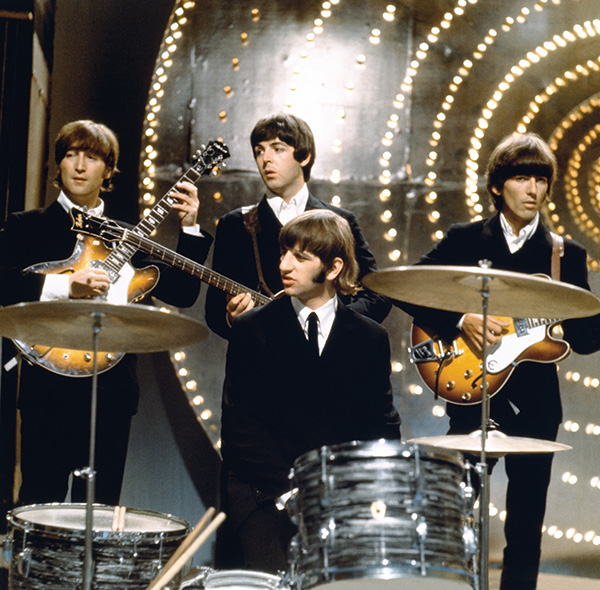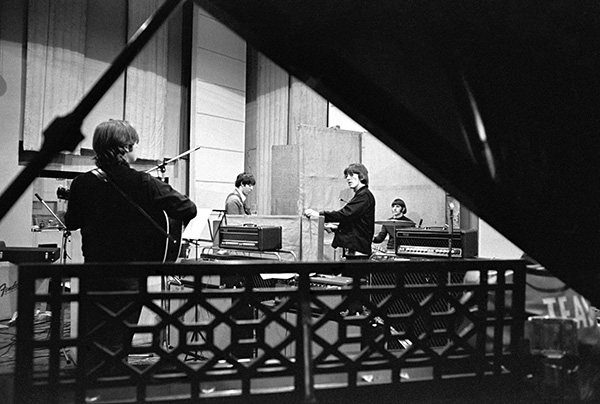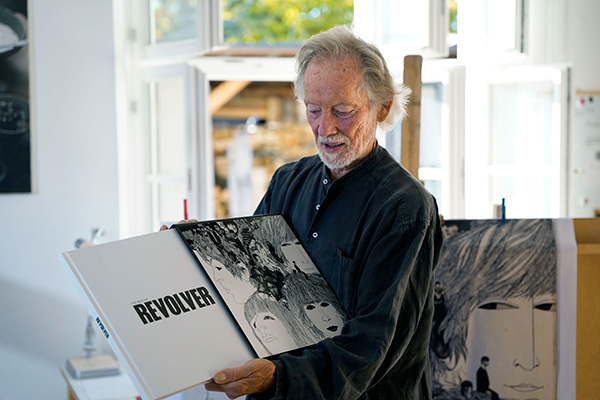| Columns Retired Columns & Blogs |
Loved every word. Yours and his. Thank you.

KM: I noticed on some of the mixes, I heard a lot of rear channel information, some were more upfront stereo. How did you make that differentiation?
GM: Depends on the content. Take "Taxman" or "Dr. Robert," which is guitar, bass, and drums. It was all recorded together, but we've demixed it. You can't put the guitar in the back, it's the band playing. But with "Yellow Submarine," the ocean and the sound effects, you can put that in the rear channels because they're not part of the band's performance. You can have the horns around you. And then the band driving in the middle. Same with backing vocals. "Tomorrow Never Knows," the tambura can circle the room and the drums and bass can be in the front. You need that center thing to lock onto. The tape loops can go over your head or around you. Then "Paperback Writer," which is basically a band in the studio. I can make the vocals a little wider, but they shouldn't come from the back because they're part of the lead vocal line. So, there's more of a u-shape to the mix opposed to a 360.
KM: As an audiophile, the speakers at Republic Studios did not sound good.
GM: Those wouldn't be my choice. I had to EQ the sound quite a lot. I did a playback last week at Abbey Road, a stereo playback, not Atmos, using ATC speakers, my studio speakers. I had to do nothing at all. Yesterday at Republic Studios I was dipping 5dB at 3k out. The speakers were too narrow for the room. But for the effect of having a communal listening to Revolver in Atmos, that space did the trick. But as an audiophile thing, that's not how the record sounds.

KM: Get Back had a similar technical approach to your mix?
GM: To reiterate, there's two separate streams here. I do a stereo, half-speed vinyl cut, and then spatial audio, for headphones for Apple. But there's two separate streams and two mixes, actually. When I do a stereo Beatles mix, like Revolver, it'll be mixed at 24/96. Abbey Road mastering engineer Miles Showell runs the mix at 24/48, so everything is half-speed. And we run the turntable at half-speed, which means the actual cut is much more precise. So, it's completely half-speed mastering, so when the vinyl is cut, the engraving's much more precise. Playback gives you a deeper, much better sound.
KM: What else accounts for this incredible enhancement of this recording?
GM: Adding room sound was only used for the spatial audio, not for the stereo. The biggest change of technology is the demixing process, where you're taking a track, which has a number of elements on it, and you separate those elements. It's like being given a cake and you hand me back eggs, milk, flour, sugar, butter.
KM: This is where AI comes into play?
GM: That is the use of artificial intelligence. This began with Get Back (aka Let It Be), a lot of which was recorded on Nagra tape. The ambition was to feel like you're in the room with the Beatles. And I think we got that, in a way, but we used so much technology to be real. We practically burned computers to be as real as possible. The dialog editor, Emile de la Rey (head of machine learning at Peter Jackson's WingNut Films Productions), was working hard; if Paul's speaking and George is playing guitar and you can't hear Paul speaking, Emile would lift the guitar off that voice.
Peter Jackson and his crew developed technology where if you put the instrument in the computer, it can find the instrument and extract the audio. I realized that we could do this with Beatles' tapes. As long as the computer has some sense of what the guitar sounded like, it could give you the guitar on its own. That's the AI machine learning part of the demixing process. Which means I can then position the band on the stereo field. So, when you listen to the stereo mix, you'll hear the band, opposed to them all being wedged into one space and compressed. And the most important thing, there's no additional material, nothing's being recreated or added to the record. So, if I take the guitar, bass, and drums from "Taxman" that have been separated, and run it with the original track, and I flip the phase, the audio disappears, which means that nothing is being [added], it's exactly the same. So, despite being separated, everything is exactly the same. That's why this Revolver mix sounds like the band's in a room. Which is what you want.
KM: Explain demixing.
GM: Demixing, it's like a restoration, it's like cleaning back layers. It means I don't have to have guitar, bass, and drums locked into one position. I can put the drums in the middle. So, Ringo's coming out of two speakers, and you hear him in the room. I can put the bass and guitar wherever I want. They don't have to be together. It allows me to EQ instruments separately.
KM: What enabled you to separate all that from the original tape?
GM: That's the AI. People have been doing this, but it's never been done this well. I did this for Eight Days a Week, the Ron Howard film: I removed the screams. I never thought we'd get to a stage where we'd have a drum kit like you heard yesterday. It doesn't sound like a drum kit with things missing or like it had been stripped of itself. You can hear the squeak of his kick pedal.

KM: And swooping, open/close hi-hats I had never heard before. What were the main issues you identified with the original mix of Revolver that needed addressing?
GM: The main issue is the fact that the instruments are locked together, because there's a four-track recording with the band on one track. And so, you can't create a stereo mix without compromise. So, everything—guitar, bass, and drums—will be together. They go on one side and the vocals on the other side. With demixing technology, we can create a new stereo mix that isn't compromised or biased in any way.
KM: Of all these songs, after you recreated them, which one had the biggest emotional impact for you?
GM: "For No One," funny enough. "For No One" is a heartbreaking song. And I was going through some tricky times when I was doing this. And it's the one that struck me. It's the one that got to me. Revolver is a strangely sad album. It's quite a dark album. "She Said," "Eleanor Rigby," "Taxman." If you think about it lyrically, "Got to Get You into My Life" is about drugs. It's a happy album in its process of making, good to listen to. But lyrically it's not like other Beatles records. It's change.
KM: After Revolver then came Sgt. Pepper, then things begin to fall apart. This is the Beatles at their most extreme and experimental, and most brilliant as songwriters, perhaps.
GM: Yeah, I think so. Abbey Road was their most successful album in lots of ways. But Revolver is a different stage for the Beatles. I think this is them throwing off the Beatles' suits of Beatlemania and becoming individuals. Then they quickly put different suits on for Sgt. Pepper. It's almost like a concept album. Working on it, mixing Revolver, it's like mixing seven or eight different bands at once. What other bands would have a string octet, or a song with one chord in it, or backwards guitars? It's not a strange album because it's so popular, but as an album, it is a strange album.
KM: Sonically, it was really closed in.
GM: Yeah. It's got a lot of compression on it, and that's the sound of it. And it still does, I had to use Fairchild [compressors] and stuff because that's the sound of Revolver. There's more of an immediacy to it now. An English guy I spoke with from the BBC said, "It's a bit like going to see an old building that's been cleaned."
KM: It's the Beatles reanimated.
GM: I'm pleased you are saying that because that's what it's meant to do. It's the dynamic. That's what's changed. So, when Ringo hits a drum, you hear him hit a drum. People think it's levels, that I turned things up and everything sounds louder, whatever. But it's not; it's just the dynamic, that you get the sense of people actually playing.
KM: How do you listen to music at home?
GM: I have ATC speakers, which are self-powered. A Marantz AV amp, which I use for Atmos. I have a couple of Cambridge Audio amps, which I think are quite good for the price. I'm thinking about a Devialet amp. I have a Vertere turntable at home. I have one in the studio as well. And I use a Vertere phono preamp. We do a half-speed mastering process for Beatles records. And I have a huge studio at Abbey Road where I have ATC monitors, and the ATC speakers at home. Also at the Abbey Road studio, a pair of Bowers and Wilkins 802 speakers, which are very different. I also have a full Atmos/Klipsch audio system, with upward-firing speakers, and a Marantz decoder. I'm head of audio and sound for Universal Music Group, so I coach and run other people's mixes as well through my various systems.
KM: What hi-fi did your father, Sir George Martin, listen to at home?
GM: He had a Trio (by Kenwood) amp and turntable and a Pioneer amp. The speakers were nothing special. He used to listen to music in the car. Which is funny. I'm based at Abbey Road Studios, so I have access to all of Abbey Road's stuff. I'm also Sound Experience Leader for Sonos. We make Wi-Fi speakers, and they're really good. The Play:1 speaker is great. A lot of professionals use them as reference small speakers.
KM: How is your studio at Abbey Road treated?
GM: My room at Abbey Road sounds exceptional. I have seven and a half feet of bass absorption in the back of the room. A floating floor. Your readers know the room has a huge effect on the sound. Each one of my monitors is loaded in its own inner cell, which is like a casing, with spring-loaded, nonvibrating mounts. I have 100 square meters of insulation around me. So my room sounds extraordinary.
KM: How far can you go with the Beatles?
GM: They give me absolute free rein. My job is to find new technology, like the demix process, and uncover and take another look at things. And if I go too far, they'll rein me back in. My job follows a very "Beatles" thought process. It's "what can you do with this?" The first Atmos spatial mix for music was the Beatles' Sgt. Pepper. That triggered the whole thing with Apple streaming spatial audio. Revolver is the first album that's ever really used this AI process of demixing. This is new technology. Yesterday, you weren't listening to technology. You were listening to an album you loved, and you were being emotionally touched by it. That's all that matters. But I like the idea that the Beatles can still break new ground in technology.
KM: You're the ultimate Beatles insider. What's your takeaway from all of this?
GM: Ultimately, it's the songs. They wrote songs that make people feel things. The Beatles are a very human band. They span generations. I remember working on a Beatles' video game, Rock Band, and my kids could sing "Yellow Submarine"—they were only 4 years old. You can journey through different Beatles' albums and find it's like having a favorite band, but there's 11 different bands. I remember someone said, "What's unique about the Beatles isn't the fact that over seven or eight years they wrote 250 songs. It's the fact that most of 'em were good." That's the Beatles

Loved every word. Yours and his. Thank you.

These new mixes prove that more is not better !

With Apple & Amazon music streaming services providing ATMOS mixes at no extra cost, I can see why the big music labels are jumping on the bandwagon (no pun intended). I hope everyone involved can make money with this!

>>>These new mixes prove that more is not better !<<<
These new mixes prove that more is not worse.